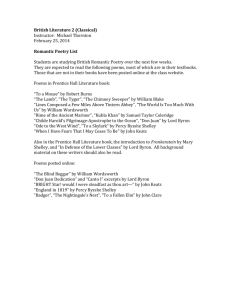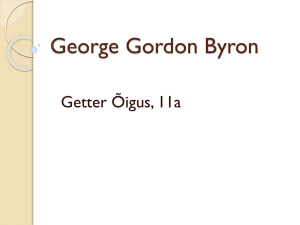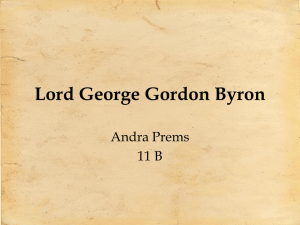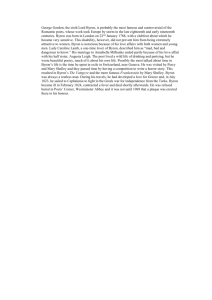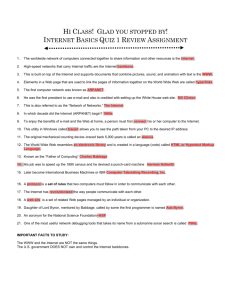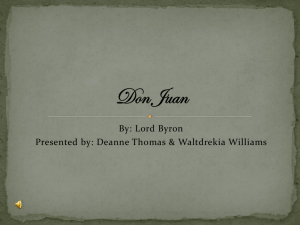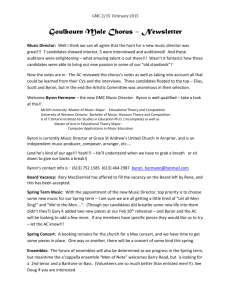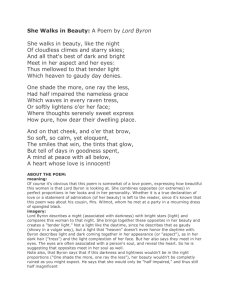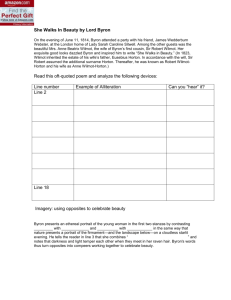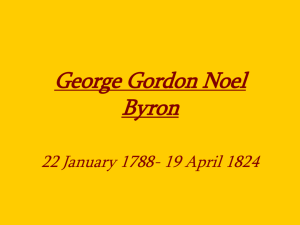Lecture 12 Lord Byron (1st hour), Childe Harold's Pilgrimage Don
advertisement
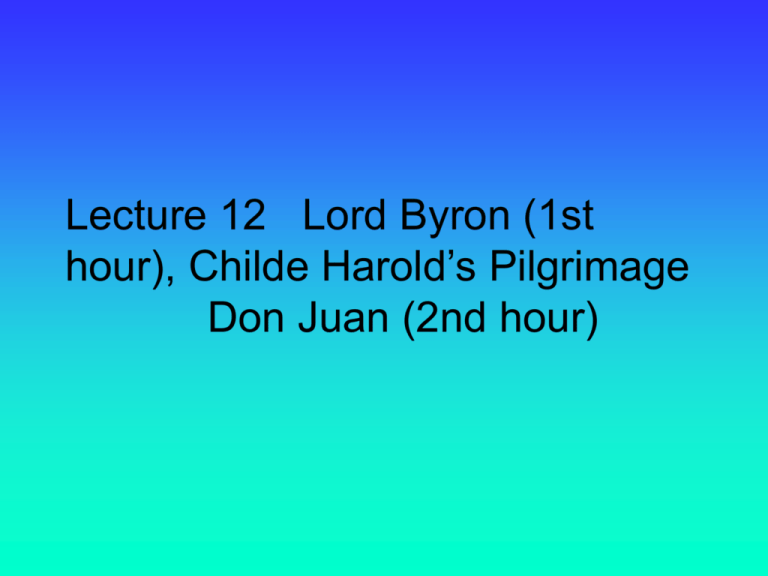
Lecture 12 Lord Byron (1st hour), Childe Harold’s Pilgrimage Don Juan (2nd hour) • George Gordon Byron was born in an impoverished noble family in London in 1788, a year before the French Revolution. His father was a captain nicknamed " Mad Jack', who had squandered away the money of the poet's mother and then deserted her. For some years mother and son lived in loneliness and poverty in Scotland. His mother, a passionate woman, petted and abused him alternately. Byron was born with a clubfoot, and in the frequent family scenes his mother called him "you lame brat.” So the poet's early years had been far from happy. • In 1815, Byron married Miss Milbank, a solemnly religious young woman who made up her mind to "reform" Byron by marrying him. It proved a most unhappy marriage. A year later, shortly after the birth of their daughter Ada, she left him and refused to come back, saying that" he was insane'. Now the freedomloving character of Byron's poetry and his "seditious speeches" in Parliament had long evoked hatred for him on the part of the English ruling classes. They grasped Byron's misfortune in family life as a pretext to launch a wholesale attack against him. "I felt" he wrote." that, if what was whispered, and mattered, and murmured, was true, I was unfit for England; if false, England was unfit for me." On April 25, 1816, he set sail for Europe, never to return. • Byron first went to Switzerland, where he made acquaintance with Shelley. The two poets visited the castle of Chillon, in which the Swiss revolutionary Bonnivard (14961570) had been imprisoned for several years. Shortly afterwards Byron wrote the famous "Sonnet on Chillon" and the narrative poem .The “Prisoner of Chillon'(1816). In Switzerland he also wrote Manfred a poetical drama, and other poems. • “Childe Harold's Pilgrimage": • This long poem contains four cantos. It is written in the Spenserian stanza, i.e. a 9-line stanza rhymed ababbcbcc, in which the first eight lines are in iambic pentameter while the ninth in iambic hexameter. The poem tells of Childe ( =a youth of noble birth) Harold's travels in Europe. Harold is a young aristocrat whose' world-weariness' bespeaks his loathing for English high society. He leaves his country to escape from the society he fears and hates. Being solitary and melancholy, he seeks the companionship of mountains and seas. • The first canto deals with Portugal and Spain. The poet praises Portugal as the "delicious land' where "fruits of fragrance blush on every tree,' but he feels acutely the poverty of the oppressed people. Then he depicts the Spaniards in their Struggle against foreign aggression. • The second canto describes Albania and Greece. The author paints pictures of the "dark blue sea", moonlit nights and places famous in ancient history. He laments over the fallen state of fair Greece", reminds the Greeks of their heroic past, and encourages them to strive for liberty with their own arms. • The third canto was written 6 or 7 years later than the first two cantos. During the long interval, the poet suffered so much from the venom and spite of the high society. • The fourth canto sings of Italy and the Italian people who have given the world great writers and thinkers like Petrarch, Dante, Boccaccio, Tasso and Galileo. Byron exposes the reactionary rulers of Europe, and especially the Holy Alliance. His ardent love of liberty and his firm belief in the people's final triumph find expression in lyrical outbursts. • "Don Juan': • "Don Juan" was written in Italy during the years 1818-1823. It is 16,000 lines long, in 16 cantos, and written in ottava rima, each stanza containing 8 iambic pentameter lines rhymed abababcc. • The story of the poem takes place in the latter part of the l8th century. Don Juan, its hero, is a Spanish youth of noble birth. The vicissitudes of his life and his adventures in many countries are described against varied social backgrounds, and he is seen to take part in different historical events, thus giving a broad panorama of contemporary life. • Don Juan, a handsome and happy-go-lucky young man, falls in love with Donna Julia, the wife of Don Alfonso. But the affair is soon discovered; Julia is Shut up and the young culprit is sent abroad. After a shipwreck in a storm, Juan escapes in a boat with thirty other Passengers. They are tossed about on the sea and, one by one die Of hunger and thirst. Juan alone comes out alive and swims to a Greek island, where he is saved by Haidee, "a child of nature" and the only daughter of Lambro, a pirate. The young people become attached to each other and the love scenes beneath the moonlit sky are described with great lyric beauty. • "Don Juan" is Byron’s masterpiece, written in the prime of his creative power. His aim in writing it was "to remove the cloke (=cloak) which the manners and maxims of [high] society throw over their secret sins. and shew t =show) them to the world as they really are." He called this poem an "epic satire". "a satire on abuses of the present state of society." "Almost all Don Juan,' he wrote, "is real life, either my own, or from people I know." In "Don Juan" Byron displayed his genius as a romanticist and a realist simultaneously. • Points of view • (1) Politically Byron has a strong passion for liberty and an intense hatred for all tyrants. He appeals for the liberty of the oppressed nations, while exalting the great fighters for freedom in history. He glorifies the French Revolution and condemns the despotic Napoleon period. He gives his strong support to the Spanish, Portuguese and Italian people fighting for their national independence. He laments over the fallen Greece, expressing his ardent wish that the suppressed Greek people should win their freedom. At the news of the Greek revolt against the Turks, Byron not only gave the insurgent Greeks financial help but also plunged himself into the struggle for the national independence of that country. • (2) Artistically, Byron continued in the tradition of classicism that had been advocated by the writers of the Enlightenment in the l8th century. He eulogized the 18th-century Enlighteners and attacked the conservative schools of contemporary poetry, showing his contempt for what he considered the commonplace and vulgarity of the "Lake Poets". • Childe Harold's Pilgrimage • This is a poem about the hero Harold, who was disillusioned in modern civilization and who decided to leave his native land for foreign countries in order to be among simpler people. The poem presents a panoramic view of all sorts of things, from colorful descriptions of national manners and customs and impressive pictures of nature to the author's philosophical reflections and his courageous political opinions. • Don Juan • Don Juan is a great comic epic, a poem based on a traditional Spanish legend of a great lover. Byron invests in Juan the moral Positives like courage, generosity and frankness, which, according to Byron, mm virtues neglected by the modern society. In addition, by making use of Juan's adventures, Byron presents a panoramic view of different types of society, painting brilliant pictures of life in its various stages of love, joy, suffering, hatred and fear. The unifying principle in Don Juan is the basic ironic theme of appearance and reality, i.e. what things seem, to be and what they actually are. The diverse materials and the clash of emotions gathered in the poem are harmonized by Byron's insight into the difference between life's appearance and its actuality. • Special features • (1) Owing to his persistent attacks on "cant political, religious, and moral", to the novelty of his oriental scenery, to the romantic character of the Byronic hero, and to the easy, fluent, and natural beauty of his verse, Byron's poetry exerted great influence on the Romantic Movement. • (2) Byron's diction, though unequal and frequently faulty, has on the whole a freedoms, copiousness and vigor. • (3) His descriptions are simple and fresh, and often bring vivid objects before the reader. Byron's poetry is like the oratory which hurries the hearers without applause. • (4) The glowing imagination of the poet rises and sinks with the tones of his enthusiasm, roughing into argument, or softening into the melody feeling and sentiments. • (5) Byron employed the Ottva Rima (Octave Stanza) from Italian mock-heroic poetry. • "The Isles of Greece" (from Don Juan, III) • Main idea • "The Isles of Greece", taken from Canto III of Don Juan, is among Byron's most effective poetical utterances on national freedom. All the 16 stanzas that constitute the song are supposed to have been sung by a Greek singer at the wedding feast of Don Juan and Haidee on an isle of Greece. In the song, by contrasting the freedom enjoyed by the ancient Greeks with the enslavement of the early 19th-century Greeks under Turkish rule, the poet calls on the Greeks to struggle for their national liberation.
